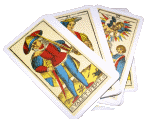
Haindl Tarot
TWO OF STONES - HARMONY
NO NEW TITLE
I CHING: 16, Yu, "ENTHUSIASM"
REVERSED I CHING: 15, CH'IEN, "MODESTY"
This picture comes from Hermann Haindl's painting of the Greek God Dionysus. Specifically the detail derives from a section of the painting meant to indicate harmony. Harmony, between people and in nature, does not come from some static state or perfect symmetry, for such a condition never exists in the real world. Instead, it follows from an exchange of energy. Harmony is constantly shifting and re-forming. We see black and gold lines flowing together. The lines actually are woven into a cloth, the tallis, or prayer shawl, of Jewish men. This links the card with the Major Arcana card of the Hierophant, the only other specifically Jewish card, which showed harmony between generations.
The hexagram is 16, which Wing calls "Harmony" and Wilhelm "Enthusiasm." The two titles go together nicely, showing how people can become enthusiastic without separating themselves from others or trying to control them. Enthusiasm brings people together when it inspires rather than commands. The upper trigram signifies movement, while the lower signifies divinity. Therefore, Wilhelm says, the strong line receives enthusiasm from the five weak ones. To do this a leader must act both in sympathy with the spirit of the people and in harmony with natural law. Wing describes this hexagram as showing a time of personal charisma. Reversed, the hexagram becomes 15, "Modesty," not so much the opposite of enthusiasm as a necessary balance to it.
The hexagram belongs to the beginning of summer, a time when we most enjoy the gifts of the Earth. At this time thunderstorms, which the ancient Chinese saw as a manifestation of the Earth's power, bring a sense of relief and joy. People make spontaneous music in harmony with nature.
Just as the tallis fabric shows dark and light lines moving together, so we see darkness and light in the picture. On the right, the fabric forms a hole, symbol of mystery, the unknown source of life. It represents both the uterus and the grave, the two gates to the other world. Haindl compares it to the hole shown on the Devil card. Opposite the hole, on the upper left, we see bright light. Light also shines below and on the sides. Of the two stones, the upper is darker than the lower. This recalls hexagram 11 from the Two of Swords, where the Receptive over the Creative signified harmony because the natural movement of each blends them together.
DIVINATORY MEANINGS
In readings, the Two of Stones signifies its title: harmonic situations, good relations between people. The card is a good indicator for business or other activities that involve people working together. It recommends a harmonizing approach, it tells us to work with others rather than alone, to inspire rather than commands. An exchange of energy goes on between people, and the person takes time to ensure that the exchange goes smoothly.
REVERSED
The reversed Two of Stones shows disharmony beginning to develop. Unless the card becomes reinforced by other, more difficult cards, such as some of the Swords, it should not mean that the disharmony has reached a point of collapse. Nevertheless, something is beginning to separate. The person needs to make a special effort to restore harmonious action, whether between people or between aspects of a situation. "Modesty," the title of the reversed hexagram, becomes valuable here. In some situations, the other cards, or the reader's intuition, may suggest that restoration cannot be achieved. Loss of harmony does not necessarily mean disaster. The time for people to move together may have passed. It may be time now for the person to be or to act alone. This, too, suggests modesty - not self-effacement, but a need to set modest goals when greater hopes become impractical.
JU - de geestdrift
HET OORDEEL
De Geestdrift. Bevorderend is het,Helpers aan te stellen en legers te laten oprukken.
HET BEELD
De donder komt uit de aarde opklinken:Het beeld van de Geestdrift.
Zo maakten de oude koningen muziek
Om de verdiensten te eren;
Zij wijdden haar als een heerlijke offerande
Aan de hoogste God,
Terwijl zij hun voorvaderen daarbij uitnodigen.










